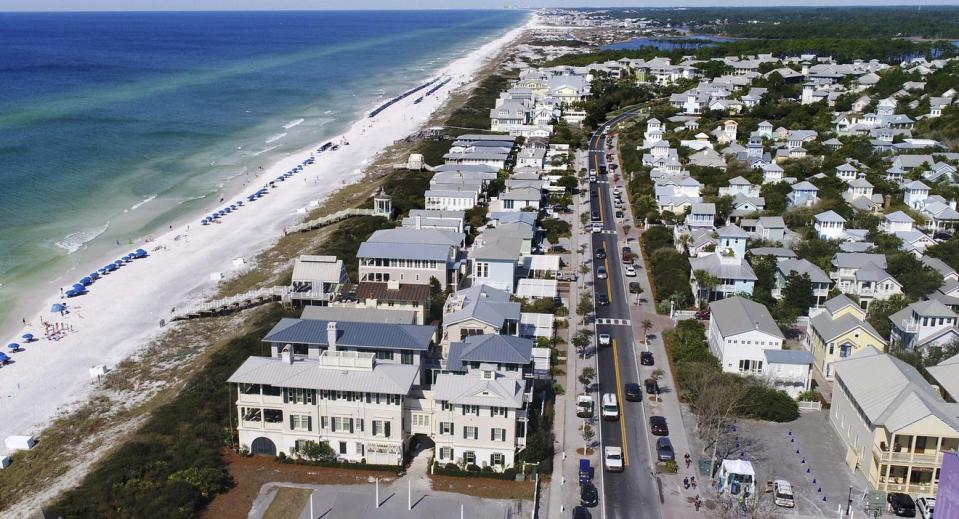Walton commissioners approve new definition of building stories. Here's what happens next.
FREEPORT — Despite a typographical error that Walton County Planning Director Mac Carpenter says has been noticed and will be fixed, the Walton County Planning Commission has unanimously approved a proposed change to the county's land development code that would change the definition of what constitutes a story on a structure.
The proposed amendment now moves forward to the Walton County Board of County Commissioners for a final decision.
As written, the proposed amendment defines a building story as "an above-grade habitable or inhabitable floor level within a building." "Habitable" and "inhabitable" each, of course, mean that a location can be lived in.
The clear intent of the amendment is to apply the definition to both inhabitable and uninhabitable space, as was understood by the Planning Commission at their Thursday meeting, and also in a January meeting by county commissioners, who directed Carpenter to develop the amendment.
Previously: What's the story on building stories? Walton officials are trying to tighten the definition.
Draper Townhomes: Controversial Walton townhome project heads toward approval; neighbors voice concern
At present, Walton County's land development code does not define what constitutes a building story. Instead, the county uses the definition in its building code — which does not count the first story of a structure if it is not habitable — as its default definition for purposes of the land development code.
That practice has, however, created difficulties with some development occurring in the county.
Most notably, the definition of building story became an issue recently in connection with Draper Townhomes, a six-townhome development coming to a tract of a little more than 0.75 acres on Walton County Highway 30A at Blue Pine Boulevard near Blue Mountain Beach.
The townhomes planned for the tract — all likely to be short-term vacation rental housing, according to the developer — would be considered four-story structures under the proposed amendment to the land development code, but are now treated as three-story structures because the bottom story is to be reserved for parking. Under the land development code, the height of a structure has implications for how far it must be set back from neighboring structures.

Residents of The Pines, a subdivision of single-story, mostly single-family homes adjacent to the Draper Townhomes site, complained that the setbacks of the planned townhomes — their distance from homes in The Pines — were inadequate to ensure privacy. People in the townhomes might be able to look into the backyards and through the windows of homes in The Pines, residents said.
Any amendment to the land development code wouldn't bring a break to residents of The Pines because the Draper Townhomes project was moving through the county's approval process before talk of amending the code began.
And according to Stephen Tatum, an attorney for Santa Rosa Beach-based Draper Townhomes LLC, the townhomes planned for the site already exceed the 19-foot setback requirements currently in the land development code, and are at 20 feet from adjacent properties.
Still, Carpenter noted at a recent public meeting on the project that the setback concerns expressed by residents of The Pines were "probably going to be the genesis of changing that in the land development code to where we look at stories one way in the building code for the purposes of life safety, and we look at stories in a different way in the land development code for the purposes of compatibility" with the surrounding neighborhood.
Carpenter repeated that in front of the Planning Commission on Thursday, telling members that "in certain areas this (the county's current way of counting stories) could have a significant impact on the compatibility of a taller structure" located adjacent to a smaller structure.
If the amendment is adopted by the County Commission, Carpenter said it won't have any effect on provisions of the state building code that are used in Walton County, in terms of sprinkler systems and other life safety provisions.
"This is specifically related to, essentially, setbacks," he said.
Walton County: Commissioners OK hotel project in Miramar Beach, taking 'common-sense approach'
The move to amend the land development code drew praise Thursday from Barbara Morano of the nonprofit South Walton Community Council.
"We worked with Mac on The Pines when this issue first came up," Morano said. "He listened to the people. ... We thank the Planning Department for looking at this."
Carpenter's move to amend the land development code, coming as it did in connection with a community concern, also earned praise from the Planning Commission on Thursday.
Panel member Dan Cosson, told Carpenter, "I'd like to thank the (county planning) staff for being proactive, for seeing a problem and identifying it and getting out ahead of it, and I am only going to hope that this is the first of an avalanche of code reform and improvements to come."
Monster houses: Residents, short term rental operators struggle at TDC workshop
County planners are already working on a proposed ordinance to more tightly regulate short-term vacation rentals amid complaints from residents that they bring noise, traffic, parking, and other problems into their backyards.
Broadly, a draft ordinance now making its way through public workshops looks at life safety issues, neighborhood compatibility issues, communication between vacation-rental owners and guests, and regulation of site design.
Among other things, the draft proposes a vacation-rental certification program in which owners of such lodgings would be required to provide information about the lodgings, including the interior layouts.
Additionally, the draft ordinance would set parking standards for short-term vacation rentals by requiring one parking space for every three occupants. Also, the ordinance would require a minimum number of trash containers for each rental.
This article originally appeared on Northwest Florida Daily News: Walton County commissioners approve new definition of building stories

